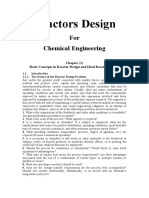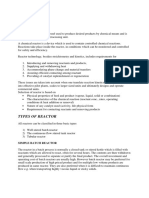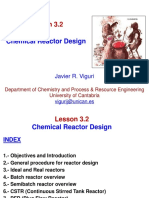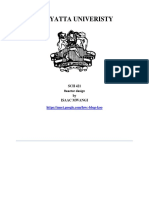The Choice and Design of Reactors
Uploaded by
xadoogarThe Choice and Design of Reactors
Uploaded by
xadoogarThe Choice and Design of Reactors: A Brief Introduction
1. Introduction
The reactor is central to a chemical manufacturing process, where chemical reactions are
carried out to transform feeds into products. Reactors are typically designed as distinct items
for a given commercial project. Many reactor designs are unique and proprietary, particularly
when the reaction system involves catalysis or multiphase flow. Even conventional stirred tank
reactors are frequently customized for the application by optimization of internal fluid-flow
pattern, feed introduction points, heat transfer surface, and process control instrumentation.
Reactor design is a critical step in the overall design of the process, and it is important to ensure
that the equipment specified are capable of achieving the desired yields and selectivity when
operated at commercial scale. Few industrial reactors are designed solely based on detailed
modelling of the kinetics and hydrodynamics; instead, reactors are usually scaled up from pilot
plant reactors or previous designs, making suitable allowance for heat transfer, mass transfer,
residence time, or other parameters that have been recognized to determine the size. In addition
to the residence time required for the reaction, various associated parameters such as internal
fluid mixing, segregation, or mass / heat transfer processes can influence the final volume of
real reactors.
The design of a reactor needs to satisfy the following requirements:
1. The chemical factors: the chemical reaction kinetics. The design must provide
sufficient residence time for the reactants so as to ensure that the required degree of
conversion is achieved.
2. The mass transfer factors: Especially with heterogeneous reactions, characterized by
presence of multiple phases where reactants and products are located, the reaction rate
may be overwhelmingly determined by the rates of diffusion of the reacting species,
rather than the chemical kinetics.
3. The heat transfer factors: Since heat effects are associated with most reactions of
commercial significance, the rate of removal or addition of the heat of reaction needs
to be considered in the overall design.
4. The safety factors: The reactor essentially encloses reactants and products which can
potentially possess hazardous properties (such as toxicity, flammability and
explosivity); this necessitates development of designs to control the reaction and the
process conditions so as to mitigate the possibility of damages due to prevalence of
abnormal reaction situations.
There is thus a need to satisfy these inter-related and often contradictory factors in the design
process, which renders it a complex and challenging task. However, in many instances it is
CL 331 / 452: Choice and Design of Reactors Page 1 of 9
found that one of the factors predominate, which, in turn determines the choice of the reactor
type and design approach.
2. Principal Types of Reactors
The following characteristics are normally used to classify reactor designs:
1. Mode of operation: batch or continuous.
2. Phases present: single (homogeneous) or multiple (heterogeneous)
3. Reactor configuration: flow pattern and manner of contacting the reactant phases
i. Stirred tank reactor;
ii. Tubular reactor;
iii. Packed bed, fixed, and moving
iv. Fluidized bed
3. Batch or Continuous Reactors
A batch reaction process commences with the addition of all the reagents along with the catalyst
(if applicable); the reaction then progresses, the compositions varying with time, in keeping
with the reaction scheme. The reaction is terminated and the product withdrawn when the
required conversion of the reactants is reached. Batch mode of reaction is typically suitable for
small to medium-scale production capacities. It is also preferred when a variety of different
products or grades, is to be produced in the same reactor, for instance, pigments, dyestuffs and
polymers.
In contrast, for continuous processes the reactants are fed to the reactor and the products
withdrawn continuously; the reactor necessarily operates under steady-state conditions.
Continuous production normally entails relatively lower production costs than batch
production; however, the latter offers greater flexibility of production. Continuous reactors are
preferred for large-scale production. Processes that do not fit the definition of batch or
continuous are often referred to as semi-continuous or semi-batch. A semi-batch reactor may
be programmed in such a manner so as to allow introduction of select reactants may be or
withdrawal of some of the products during the course of the reaction cycle. On the other hand,
a semi-continuous process can be one which is halted intermittently to carry out a specific
associated process; for example, for the regeneration of catalyst.
4. Homogeneous or Heterogeneous Reactors
Homogeneous reactions are those in which the reactants, products, and any catalyst form one
continuous phase: gaseous / liquid / solid.
Homogeneous gas-phase reactors are always operated continuously, whereas liquid-phase
reactors may be either batch or continuous. Tubular reactors are normally used for homogenous
reactions, for example, in the thermal cracking of petroleum crude oil fractions to ethylene and
CL 331 / 452: Choice and Design of Reactors Page 2 of 9
in thermal decomposition of dichloroethane to vinyl chloride. Both tubular and stirred tank
reactors are employed for homogeneous liquid-phase reactions.
In heterogeneous reactions, two or more phases co-exist, and the reactants and or products may
be located in different phases. The key challenge in the design of such multi-phase reactors is
to ensure adequate mass transfer between the phases so that the reactions proceed at the
desirable rate. Several combinations of phases are possible:
1. Liquid-liquid: in these instances, liquid phases are immiscible; example reactions
include the nitration of toluene or benzene with mixed acids, and emulsion
polymerizations.
2. Liquid-solid: Typically, one or more liquid-phases are required to be in contact with a
solid for reaction to progress. The solid may be reactant or catalyst.
3. Liquid-solid-gas: In these systems the solid is usually a catalyst; examples include the
hydrogenation of amines, using a slurry of platinum or activated carbon as a catalyst.
4. Gas-solid: The solid may take part in the reaction either as a reactant or as a catalyst.
The reduction of iron ores in blast furnaces and the combustion of solid fuels are
examples in which the solid is a reactant.
5. Gas-liquid: In these reaction systems the liquid may act as a reactant or as a catalyst.
5. Reactor Configuration (Type)
The reactors used for well-known commercial processes are usually complex in designs that
have evolved over a period of years to suit the requirements of the process and are often
distinctive in design. Nevertheless, it is expedient to classify reactor designs into the broad
categories discussed below. The various reactor configurations are illustrated in Fig. 1.
Stirred Tanks Reactors
Stirred tank (agitated) reactors consist of a tank fitted with a mechanical agitator and a cooling
jacket or coils. They may be operated in either batch or continuous mode. Often several such
reactors may be used in series so as to achieve the desired conversion at the end of the sequence.
Considered the basic chemical reactor configuration, the stirred tank reactor can be modelled
as a large-scale the conventional laboratory flask. Such reactor tank sizes range from a few
litres to several thousand litres. They can be employed for both homogeneous and
heterogeneous liquid-liquid and liquid-gas reactions that comprise suspended fine solids, held
in suspension by agitation. The degree of agitation can be controlled so as to achieve good
mass transfer or heat transfer as required.
When operated as a continuous process, the composition in the reactor is constant over time
and it is the same as that of the product stream, and, except for the very rapid reactions, this
will limit the conversion that can be obtained in one stage.
CL 331 / 452: Choice and Design of Reactors Page 3 of 9
Fig. 1 Ideal reactors and corresponding real reactors
The power requirements for agitation depends on the degree of agitation required and typically
ranges from about 0.2kW/m3 for moderate mixing, to about 2.0kW/m3 for high degree of
mixing.
Tubular Reactors
Tubular reactors (fig. 2) are generally used for gaseous reactions but are also suitable for some
liquid-phase reactions.
If high heat transfer rates are required, small diameter tubes are used to increase the surface
area to volume ratio. Several tubes may be arranged in parallel, connected to a manifold or
fitted into a tube sheet, the arrangement being similar to a shell and tube heat exchanger. For
high temperature reactions the tube manifold may be placed within a furnace.
The pressure drop and heat transfer coefficients in empty tube reactors can be computed using
the usual fluid mechanical methods applicable for flow in pipes.
CL 331 / 452: Choice and Design of Reactors Page 4 of 9
Fig. 2. An example tubular reactor configuration
Packed-bed Reactors
There are two basic types of packed-bed reactors: those in which the solid is a reactant and
those in which the solid is a catalyst (fig. 3). Examples of the first type are found in the
extractive metallurgical industries.
Fig. 3 An example fixed (packed)-bed reactor configuration
In the chemical process industries, one is normally be concerned with the second type: catalyst
reactors. Industrial packed-bed catalytic reactors range in size from small tubes a few
centimetres in diameter, to large diameter – of the order of a few metres – packed beds. Packed-
bed reactors are employed for both gas and gas-liquid reactions. Heat transfer rates in large-
diameter packed beds are generally not high; where high heat transfer rates are required; often
inter-stage cooling may be an effective design strategy (fig. 4). However, fluidized beds
provide can sometimes provide better option.
Fluidized-bed Reactors
The essential feature of a fluidized-bed reactor is that the solids are held in suspension by the
upward flow of the reacting fluid; this promotes high mass and heat transfer rates alongside
good mixing. Fluidization can be used only with relatively small-sized particles, < 300μm with
gases. The solids may be a catalyst, a reactant in fluidized combustion processes, or an
CL 331 / 452: Choice and Design of Reactors Page 5 of 9
Fig. 4 Fixed bed reactor with inter-stage cooling
inert powder added to promote heat transfer. Heat transfer coefficients in the order of 200W/m2
o
K to jackets and internal coils (placed within the reactor bed) are typically obtained. Fig. 5
illustrates various fluid flow pattern that obtain in fluidized-bed reactors depending on the fluid
velocity through the solid bed.
Fig. 5 Example fluidized-bed reactor configurations
Though the principal advantage of a fluidized-bed over a fixed bed is the higher heat transfer
rate (along with improved contact between the reactants and catalyst), fluidized beds are also
useful where it is necessary to transport large quantities of solids as part of the reaction process,
such as where catalysts are transferred to another vessel for regeneration.
CL 331 / 452: Choice and Design of Reactors Page 6 of 9
Considerable research and development work have been carried out on fluidized-bed reactors
over the last few decades, but the design and scale-up of large diameter reactors is still subject
to uncertainty which makes theoretical / modelling approach to design difficult; the relevant
methodologies are, thus, largely empirical.
Slurry Reactors
Slurry reactors are often employed for liquid-solid reactions (fig. 6). The gas or vapor is
typically bubbled or sparged into a slurry reactor, and the mass transfer rate from gas to liquid
can be predicted using the same correlations used for stirred tanks. When a gas is fed to a slurry
reactor, provision must be made for separation of the vapor and liquid in the head space and
for recovery of entrained liquid from the exiting gas.
Fig. 6 Slurry reactor
Trickle-bed Reactors
In a trickle-bed reactor the liquid flows down over the surface of a stationary bed of solids. The
gas phase usually also flows downwards with the liquid, but counter-current flow is feasible as
long as flooding conditions are avoided. The surface area provided by the solid helps promote
vapor-liquid mass transfer, and both the liquid and vapor phase have little back-mixing and
approximate plug flow behaviour. Examples of processes that use trickle-bed reactors include
the hydrocracking of heavy oils and reactions over immobilized organisms in gel columns.
6. Overall Reactor Design Procedure
The general procedure for reactor design is as follows:
1. Collect together all the kinetic and thermodynamic data on the desired reaction and the
side reactions. It may be difficult to obtain such data from the open literature, especially
on commercially attractive processes since most of them are proprietary in nature. The
kinetic data required for reactor design are obtained from laboratory and pilot plant
(experimental) studies. Such studies typically aim at measurement of the rate of reaction
over a range of operating conditions: pressure, temperature, flow rate, and catalyst
CL 331 / 452: Choice and Design of Reactors Page 7 of 9
concentration. These, in turn, are used to found a chemical reaction rate equation useful
for prediction of conversion in time.
2. Collect the physical property data required for the design, either from the literature, or
by estimation; or, if necessary, from laboratory measurements.
3. Identify the predominant rate-controlling mechanisms: kinetic, mass or heat transfer.
4. Choose an appropriate reactor type, based on industry experience with similar reactions,
or from laboratory or pilot plant studies.
5. Make an initial selection of the reactor conditions to give the desired conversion and
yield.
6. Size the reactor and estimate its performance. Exact analytical solutions of the design
relationships are rarely possible; semi-empirical methods based or analysis of idealized
reactors will normally have to be employed.
7. Select suitable material of construction for the reactor. Make a preliminary mechanical
design for the reactor: the vessel design, heat transfer area, internals and general
arrangement.
8. Estimate the cost of the proposed design, capital and operating, and repeat steps 4 – 6,
as necessary to optimize the design.
When the reactor conditions, particularly the conversion, are chosen and the design optimized,
the interaction of the reactor design with the other process operations must be examined. The
degree of conversion of the raw materials in the reactor will determine the size and the cost of
any equipment needed to separate and recycle unreacted materials. In such cases the reactor
and the associated unit needs to be optimized as a unit.
7. Reactor Performance
A few comments on performance of real reactors are warranted. The performance of
commercial-scale reactors is often difficult to predict from laboratory experiments and
theoretical models. Many factors (especially. fluid flow patterns and nature of contact between
reactants, which can vary both in time and space) can affect reactor performance, particularly
for catalytic or biological processes. If the experimental system does not carefully control these
factors and provide a realistic model of the mixing and heat transfer that will be achieved in
the real reactor, different performance may be obtained when the reaction is carried out at
actual production scale.
8. Safety Considerations in Reactor Design
The reactor is the central equipment in a chemical manufacturing process as it brings together
reactive species which themselves could be hazardous in nature. In addition, often large
magnitude of energy is released as heat during the progress of the reaction, which, if
uncontrolled, can cause the reaction to “runaway” resulting in abnormally temperatures and
consequent reactor damage with catastrophic consequences. When an exothermic reaction is
CL 331 / 452: Choice and Design of Reactors Page 8 of 9
unavoidable, one must ensure that the temperature change of the reaction mixture can be
carefully controlled and that the reaction can quickly be shut down if temperature control is
lost. Lastly, residence times of process substances can be higher in reactors compared to that
in other process equipment, resulting in higher inventories in the former. All the above features
result in the reactor being particularly hazardous in operation, which must be managed with
special considerations during design.
The application of the principle of inherently safer design (ISD) – a concept that is increasingly
applied across chemical processes – can be particularly useful in the context of reactor design.
The core principles are to eliminate hazardous reaction conditions (eliminate), reduce
inventories (minimize), use less hazardous reactants (substitute), operate under less hazardous
conditions (moderate), and eliminate operational complexity so that (human) errors are less
likely to occur (simplify). It needs to be underscored that often one of these principles will have
to be traded off against another. For example, use of moderate reaction conditions by operating
at a lower temperature will lead to a lower reaction rate and hence entail a longer residence
time and higher inventory. One, thus, needs to explore several options / parametric
combinations in applying the principles of ISD – with care and diligence – in arriving at an
optimized reactor design and operation.
Bibliography:
1. Gavin, T., and Ray, S. (2022) Chemical Engineering Design, Butterworth-Heinemann,
3rd edition.
2. Kletz, T. A., & Amyotte, P. (2010). Process plants: A handbook for inherently safer
design (2nd ed.). CRC Press
3. Levenspiel, O. (1998). Chemical Reaction Engineering (3rd ed.). Wiley.
4. Rase, H. F. (1977). Chemical Reactor Design for Process Plants (Vol. 2). Wiley.
CL 331 / 452: Choice and Design of Reactors Page 9 of 9
You might also like
- Project Report of Production of Butadiene From Butane Part 1100% (3)Project Report of Production of Butadiene From Butane Part 122 pages
- Selection of Reaction Vessel Simple/Ideal LifeNo ratings yetSelection of Reaction Vessel Simple/Ideal Life27 pages
- Reactors Design: For Chemical EngineeringNo ratings yetReactors Design: For Chemical Engineering5 pages
- 2 Chemical Reactor To Reactor Safety PDFNo ratings yet2 Chemical Reactor To Reactor Safety PDF41 pages
- Reactor Types and Their Industrial Applications100% (6)Reactor Types and Their Industrial Applications33 pages
- Dr. Muhammad Rashid Usman: Institute of Chemical Engineering and Technology University of The Punjab, Lahore 54590No ratings yetDr. Muhammad Rashid Usman: Institute of Chemical Engineering and Technology University of The Punjab, Lahore 5459029 pages
- Reactors Can Be Selected Depending Upon Following FactorsNo ratings yetReactors Can Be Selected Depending Upon Following Factors5 pages
- Classification & Selection of Chemical ReactorsNo ratings yetClassification & Selection of Chemical Reactors3 pages
- Batch Reactor: Department of Chemical EngineeringNo ratings yetBatch Reactor: Department of Chemical Engineering12 pages
- SCH 421 Reactor Design WEEK 1 & 2 Notes-1No ratings yetSCH 421 Reactor Design WEEK 1 & 2 Notes-115 pages
- Chemical Product and Process Design: Dr. Aprilina Purbasari, ST, MTNo ratings yetChemical Product and Process Design: Dr. Aprilina Purbasari, ST, MT32 pages
- Lesson 3.2. Chemical Reactors Design PDFNo ratings yetLesson 3.2. Chemical Reactors Design PDF28 pages
- Lecture 1 - Fundamentals of Chemical Reactors DesignNo ratings yetLecture 1 - Fundamentals of Chemical Reactors Design34 pages
- Chemical Reactors: Batch Reactors Are Used For Most of The Reactions Carried Out in A Laboratory. The Reactants AreNo ratings yetChemical Reactors: Batch Reactors Are Used For Most of The Reactions Carried Out in A Laboratory. The Reactants Are4 pages
- Chapter Two Design of Isothermal ReactorsNo ratings yetChapter Two Design of Isothermal Reactors19 pages
- Factors To Be Considered in Designing and Selecting A Suitable Reactor For An Industrial Process100% (2)Factors To Be Considered in Designing and Selecting A Suitable Reactor For An Industrial Process3 pages
- Overview of Chemical Reaction EngineeringNo ratings yetOverview of Chemical Reaction Engineering7 pages
- Chapter Two Design of Isothermal Reactors: 1-Batch System (Batch Reactor)No ratings yetChapter Two Design of Isothermal Reactors: 1-Batch System (Batch Reactor)20 pages
- Chemical Reactor Design-CHEM-E7135: Yongdan LiNo ratings yetChemical Reactor Design-CHEM-E7135: Yongdan Li57 pages
- Catalyst Science Úá& Reactor TechnologyNo ratings yetCatalyst Science Úá& Reactor Technology139 pages
- Multiphase Catalytic Reactors: Theory, Design, Manufacturing, and ApplicationsFrom EverandMultiphase Catalytic Reactors: Theory, Design, Manufacturing, and ApplicationsNo ratings yet
- Membrane Reactor Engineering: Applications for a Greener Process IndustryFrom EverandMembrane Reactor Engineering: Applications for a Greener Process IndustryNo ratings yet
- EPSRC Thermal Management Sheffield Drying Tech Feb 2010 PDFNo ratings yetEPSRC Thermal Management Sheffield Drying Tech Feb 2010 PDF50 pages
- Hydrodynamics of Gas-Solid FluidizationNo ratings yetHydrodynamics of Gas-Solid Fluidization53 pages
- (Ted M. Knowlton, Chair) Proceedings of InternationalNo ratings yet(Ted M. Knowlton, Chair) Proceedings of International832 pages
- Prepared By: Ankita Yagnik Assistant Professor Akshar-Preet Institute of Pharmacy100% (1)Prepared By: Ankita Yagnik Assistant Professor Akshar-Preet Institute of Pharmacy65 pages
- A Presentation On Open Ended Project Topic:-Fluidization Subject: - Fluid Flow OperationNo ratings yetA Presentation On Open Ended Project Topic:-Fluidization Subject: - Fluid Flow Operation20 pages
- Fluidized bed - Wikipedia, the free encyclopediaNo ratings yetFluidized bed - Wikipedia, the free encyclopedia5 pages
- Salt Line-Jiangsu Hanpu Mechanical Technology Co.,ltdNo ratings yetSalt Line-Jiangsu Hanpu Mechanical Technology Co.,ltd15 pages
- Mohd Yunos 2019 IOP Conf. Ser.A Mater. Sci. Eng. 554 012005No ratings yetMohd Yunos 2019 IOP Conf. Ser.A Mater. Sci. Eng. 554 01200516 pages
- Figure 1: Basic Design of Fluidized-Bed Reactor0% (1)Figure 1: Basic Design of Fluidized-Bed Reactor3 pages
- Fluidization Engineering: Lecture 09: Calculation of Gas Pumping Power Consumption in Fluidized BedNo ratings yetFluidization Engineering: Lecture 09: Calculation of Gas Pumping Power Consumption in Fluidized Bed167 pages
- Project Report of Production of Butadiene From Butane Part 1Project Report of Production of Butadiene From Butane Part 1
- Dr. Muhammad Rashid Usman: Institute of Chemical Engineering and Technology University of The Punjab, Lahore 54590Dr. Muhammad Rashid Usman: Institute of Chemical Engineering and Technology University of The Punjab, Lahore 54590
- Reactors Can Be Selected Depending Upon Following FactorsReactors Can Be Selected Depending Upon Following Factors
- Chemical Product and Process Design: Dr. Aprilina Purbasari, ST, MTChemical Product and Process Design: Dr. Aprilina Purbasari, ST, MT
- Lecture 1 - Fundamentals of Chemical Reactors DesignLecture 1 - Fundamentals of Chemical Reactors Design
- Chemical Reactors: Batch Reactors Are Used For Most of The Reactions Carried Out in A Laboratory. The Reactants AreChemical Reactors: Batch Reactors Are Used For Most of The Reactions Carried Out in A Laboratory. The Reactants Are
- Factors To Be Considered in Designing and Selecting A Suitable Reactor For An Industrial ProcessFactors To Be Considered in Designing and Selecting A Suitable Reactor For An Industrial Process
- Chapter Two Design of Isothermal Reactors: 1-Batch System (Batch Reactor)Chapter Two Design of Isothermal Reactors: 1-Batch System (Batch Reactor)
- Multiphase Catalytic Reactors: Theory, Design, Manufacturing, and ApplicationsFrom EverandMultiphase Catalytic Reactors: Theory, Design, Manufacturing, and Applications
- Membrane Reactor Engineering: Applications for a Greener Process IndustryFrom EverandMembrane Reactor Engineering: Applications for a Greener Process Industry
- EPSRC Thermal Management Sheffield Drying Tech Feb 2010 PDFEPSRC Thermal Management Sheffield Drying Tech Feb 2010 PDF
- (Ted M. Knowlton, Chair) Proceedings of International(Ted M. Knowlton, Chair) Proceedings of International
- Prepared By: Ankita Yagnik Assistant Professor Akshar-Preet Institute of PharmacyPrepared By: Ankita Yagnik Assistant Professor Akshar-Preet Institute of Pharmacy
- A Presentation On Open Ended Project Topic:-Fluidization Subject: - Fluid Flow OperationA Presentation On Open Ended Project Topic:-Fluidization Subject: - Fluid Flow Operation
- Salt Line-Jiangsu Hanpu Mechanical Technology Co.,ltdSalt Line-Jiangsu Hanpu Mechanical Technology Co.,ltd
- Mohd Yunos 2019 IOP Conf. Ser.A Mater. Sci. Eng. 554 012005Mohd Yunos 2019 IOP Conf. Ser.A Mater. Sci. Eng. 554 012005
- Fluidization Engineering: Lecture 09: Calculation of Gas Pumping Power Consumption in Fluidized BedFluidization Engineering: Lecture 09: Calculation of Gas Pumping Power Consumption in Fluidized Bed

























































































